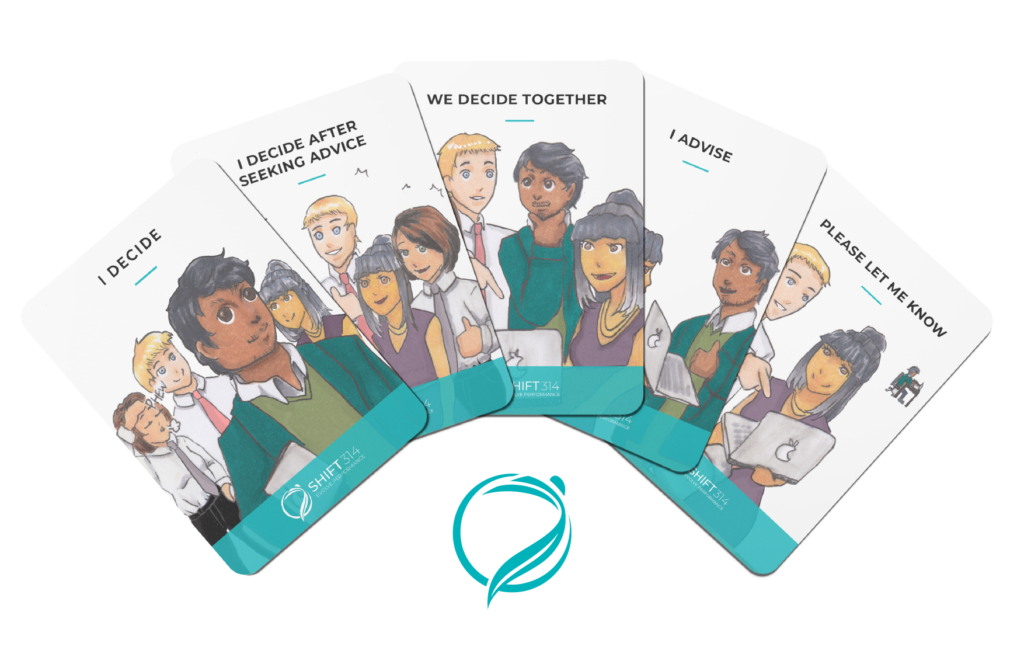Shared leadership is about sharing power and developing other leaders. If you, as a leader, are not able to develop and inspire the brilliance of others, then your leadership is soon to fail.
It sounds harsh, but that’s the truth. Many people misunderstand leadership as being the one with the big, bright idea. Others think of leadership as being the one who’s going to rally the flag and get people to follow. That may be part of it – sometimes as leaders, we do those things because it’s needed.
Yet the real measure of your success as a leader is, are you able to develop other leaders around you? And are those leaders able to develop other leaders? That’s really the test – because when we achieve this, then we will have leaders at all levels of the organizational system. When we have leaders at all levels, then everyone shines at their full potential. Everyone is able to contribute to the maximum of their capability and performance continuously improves.

To the extent that there are leaders at all levels, an organization can distribute decision-making to responsible people who will make the right decision or get advice to make sure that together, they make the best decisions for the organization. Shared leadership means the workforce of your organization is able to navigate the complex world of business while showing up engaged, motivated, and high-performing.
This creates a culture of work that enables the creation of amazing products and services that are going to resonate with customers. As leaders take care of the employees and give them the attention they need to unlock their success, the employees take care of our customers and create an awesome experience. Performance starts and ends with shared leadership.
What Is Shared Leadership, Really?
What does shared leadership really mean? Many leaders make the mistake of believing shared leadership means to give away power without the right environment. We at SHIFT314 advise developing maturity and environment first before sharing power. We call it The Paradox of Power.

As a leader, let’s say we’re the holder of power. Our work is to understand, when do we use that power for the good of the whole system? When do we use that power to develop other leaders? And when do we share that power with other people so that they can lead? When we share power, others take on the responsibility of moving the organization forward to serve its mission.
The Paradox of Power
There’s one important caveat about sharing power – as the holder of power, we want to be very aware of other people’s level of capability. How much support do they need? How much autonomy do they need? How involved do I need to be to help them make sure that they have the responsible use of power? If they make mistakes, how do I support people in learning from them? The work of shared leadership is that of understanding what we call “the Paradox of Power.”:
- When to use power for the good of the system and the good of the people.
- When to share power to help unlock all the people around us and create more rapid decision-making across the organization.
Shared Leadership = High Performance
In most organizations, only the people at the very top are making big decisions and people at mid-levels are making smaller decisions. People at the bottom are just following orders.

In a traditional organizational system, only the people at the very top have their brains turned on fully. As you go down the levels, people’s brains are successively shut off until, at the very bottom, people are just told to follow orders.
In a traditional organization, it takes a long time to make decisions – they go all the way up the hierarchy and then have come all the way back down. Traditional organizations move very, very slowly. Leaders at the top have a limited view of what is needed “on the floor”, they do not have daily sight into what is going on or have all the knowledge needed to make a decision. All the context and all the nuances are lower down: these details are lost in translation. So the decisions made at the top are usually not the best decisions to promote high performance.
Building Leaders at all Levels
In a high-performance organizational system, we build leaders at all levels. The decision-making is shared. People responsibly use power so that anybody can say, “I’m sensing a customer opportunity,” or “I’m sensing a market problem which we need to address.” If they know how to lead, if they are mature and groomed to make decisions, and if they have enough information locally, they can make those decisions quickly with the people that are impacted and connected with the issue.

If it’s a much broader decision than their local area, they will be encouraged to involve other people to pull advice and say, “Hey, I’m looking at this problem. We think it might touch these other areas. What do you guys think we should be doing about this?”
When everyone is showing up as a leader, they are going to own the decisions they make. This means they will make sure they have all the information, know the impact, and have the necessary conversations to make the best decision for that organization. With Shared Leadership, hundreds of incredibly good decisions can be made daily across the organization with good knowledge and use of collective wisdom.
As you open up the system by building leaders, you expand people’s capabilities to make decisions. It builds psychological safety and begins to build trust within your organizational workforce.
Where to Begin? Kicking the Command and Control Habit
What does it take to achieve shared leadership? There are a few obstacles.
- Human beings have a habit of command-and-control behaviors
- Most people are not aware of this habit
- Most people are not even aware of how this habit is impacting their performance as a leader

What does this have to do with shared leadership? Shared leadership is about kicking the command and control habit. It’s about learning how to not be in control, to not be the smartest one in the room or the one with all the power. Instead, this is leadership that understands that high performance comes from building leaders around you and celebrating the amazingness of other human beings.
To harness extraordinary leadership, it is important to kick the command and control habit. This means becoming aware of the ego, which has been out of control our whole lives. We need to see the impact the ego has on everything around us and learn how to overcome its damaging effects. This is a requirement to successfully share leadership.
“With great power, comes great responsibility”
Leadership comes with a responsibility to the organizations we serve and the people whom we lead. Throughout history, we have seen leadership and power used to oppress people. We have the data to understand the impact – to realize that this type of leadership does not lead to high performance. We all know the power and impact of leaders who had the courage and presence to lead through sharing leadership, building leaders around them.
The problem is not that we have no evidence, the problem is that we fail ourselves as leaders. We forget how to truly lead because our own need for success and survival – the ego – pervasively kicks in, takes over and we become something other than ourselves. We all know how to treat people well, build and nurture the brilliance of others. We know how to develop and shape people into powerful leaders, yet we struggle to do this in the face of the realities and complexities of the complex business world.

To summarize, there is nothing wrong with leading and using power. The problem is the habit with which we use our power. When become unconscious using power without thinking about the impact and consequences, we fall into the habit of commanding and controlling others to try to force success. This never works.
Tools to Share Leadership and Power
Ultimately, what’s needed is an inner shift in our consciousness or mindset to show up as extraordinary leaders. As leaders who can develop leaders around us, share power effectively, and create high-performance organizations. When we realize that our success depends on everyone else’s success, and on helping everyone else be rock stars, we unlock our own leadership. When we have that inner shift, the right actions just happen naturally. There’s no script needed. And the truth is we’re not there yet, and having tools can help us take steps in the right direction.
Three Powerful Tools for Cultivating Shared Leadership
Here are three powerful tools that you can use to start cultivating shared leadership today. We’ve tested and refined these tools with business leaders around the world. They are simple and effective.
#1 Decision Cards: Learn to Share Power
The first tool is called Decision Cards. You can use them to increase awareness and options around who makes decisions and how those decisions are made. For example:
- I Decide: I make this decision alone.
- I Decide After Seeking Advice: This decision is mine to make. I will make it after seeking advice from those impacted and those who have experience with this decision or domain.
- We Decide Together: This decision is mine to make with others.
- I Advise: This is not my decision. I am impacted or have experience that I will share with the decision-maker.
- Please Let Me Know: I have nothing to contribute to this decision.

#2 Advice Process: Develop Decision Making Skills
The second technology is the Advice Process. It’s about, how do I ask for help or get input and advice on a decision from others so that we can make the best decision for this organizational system? Not necessarily for me and my group, but for the organizational system as a whole.
#3 Red List/Green List: Spotlight the Command & Control Habit
There’s a third tool that is also very high up on the list of kicking the command and control habit, which is the Red List/Green List. This is a powerful tool to unlock your leadership very quickly (works at home with kids too!). It’s all about how to overcome resistance and move from a command and control habit to a shared leadership mindset.
How To Make the Shift to Shared Leadership?
Showing up as an extraordinary leader takes effort, desire, and evolution. There is a complex shift in the practical skills and an inner shift for a leader to navigate the paradox of power in order to achieve shared leadership. The SHIFT Evolutionary Leadership Framework™ (SELF) provides the maps, models, principles, and tools needed to make that shift.


